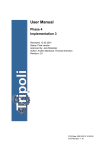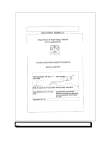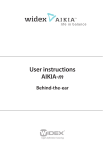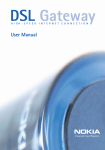Download User`s instructions The Flash Series
Transcript
User’s instructions The Flash Series FL-9 / FL-9é Behind-the-ear These user’s instructions describe two hearing aid models: FL-9 and FL-9é Unless otherwise indicated, all information applies to both models. Where it is specific to either the FL-9 or the FL-9é model, please make sure that you read the information that pertains to your model. The hearing aid, earmould, é-tip and accessories shown may not look the same as the ones you have. We furthermore reserve the right to make any changes considered necessary. Hearing aids and their accessories should not be disposed of with normal household waste. Please consult your national Widex distributor for advice on how to dispose of your hearing aid. 2 Contents Your new Flash hearing aid . . . . . . . . . . . . . . . . . . . . . . . . . . . . . . . . . . . . . . . 4 Flash (FL-9) . . . . . . . . . . . . . . . . . . . . . . . . . . . . . . . . . . . . . . . . . . . . . . . . . . . . . . . 5 Flash élan (FL-9é) . . . . . . . . . . . . . . . . . . . . . . . . . . . . . . . . . . . . . . . . . . . . . . . . . 6 The élan ear-set . . . . . . . . . . . . . . . . . . . . . . . . . . . . . . . . . . . . . . . . . . . . . . . . . . 7 The battery. . . . . . . . . . . . . . . . . . . . . . . . . . . . . . . . . . . . . . . . . . . . . . . . . . . . . . . 8 Battery type. . . . . . . . . . . . . . . . . . . . . . . . . . . . . . . . . . . . . . . . . . . . . . . . . . . 8 Inserting the battery . . . . . . . . . . . . . . . . . . . . . . . . . . . . . . . . . . . . . . . . . . 9 Changing the battery . . . . . . . . . . . . . . . . . . . . . . . . . . . . . . . . . . . . . . . .10 Turning the hearing aid on and off . . . . . . . . . . . . . . . . . . . . . . . . . . . . . . .11 Right/left identification . . . . . . . . . . . . . . . . . . . . . . . . . . . . . . . . . . . . . . . . . .12 Placing Flash (FL-9) on/in the ear. . . . . . . . . . . . . . . . . . . . . . . . . . . . . . . . .13 Placing Flash élan (FL-9é) on/in the ear . . . . . . . . . . . . . . . . . . . . . . . . . . .15 Possible settings when turning on your hearing aid. . . . . . . . . . . . . . .16 Removing Flash . . . . . . . . . . . . . . . . . . . . . . . . . . . . . . . . . . . . . . . . . . . . . . . . .17 Automatic adjustment of loudness. . . . . . . . . . . . . . . . . . . . . . . . . . . . . . .18 Fine tuning loudness . . . . . . . . . . . . . . . . . . . . . . . . . . . . . . . . . . . . . . . . . . . .19 Listening programs. . . . . . . . . . . . . . . . . . . . . . . . . . . . . . . . . . . . . . . . . . . . . .20 Switching between the listening programs . . . . . . . . . . . . . . . . . . .22 Keeping Flash (FL-9) clean . . . . . . . . . . . . . . . . . . . . . . . . . . . . . . . . . . . . . . .25 Cleaning accessories . . . . . . . . . . . . . . . . . . . . . . . . . . . . . . . . . . . . . . . . .25 The hearing aid . . . . . . . . . . . . . . . . . . . . . . . . . . . . . . . . . . . . . . . . . . . . . .26 The earmould . . . . . . . . . . . . . . . . . . . . . . . . . . . . . . . . . . . . . . . . . . . . . . . .26 Keeping Flash élan (FL-9é) clean . . . . . . . . . . . . . . . . . . . . . . . . . . . . . . . . .28 Cleaning accessories . . . . . . . . . . . . . . . . . . . . . . . . . . . . . . . . . . . . . . . . .28 Cleaning the hearing aid . . . . . . . . . . . . . . . . . . . . . . . . . . . . . . . . . . . . .29 Cleaning the élan ear-set . . . . . . . . . . . . . . . . . . . . . . . . . . . . . . . . . . . . .29 Changing the Flash élan (FL-9é) ear-set . . . . . . . . . . . . . . . . . . . . . . . . . .32 Individualising the élan ear-set . . . . . . . . . . . . . . . . . . . . . . . . . . . . . . .33 Caring for your hearing aid . . . . . . . . . . . . . . . . . . . . . . . . . . . . . . . . . . . . . .37 Special care tips for Flash élan (FL-9é) . . . . . . . . . . . . . . . . . . . . . . . . . . . .39 Good advice. . . . . . . . . . . . . . . . . . . . . . . . . . . . . . . . . . . . . . . . . . . . . . . . . . . . .41 Accessories. . . . . . . . . . . . . . . . . . . . . . . . . . . . . . . . . . . . . . . . . . . . . . . . . . . . . .43 Audio input . . . . . . . . . . . . . . . . . . . . . . . . . . . . . . . . . . . . . . . . . . . . . . . . . .43 FM systems . . . . . . . . . . . . . . . . . . . . . . . . . . . . . . . . . . . . . . . . . . . . . . . . . .46 In case of malfunction of Flash (FL-9) . . . . . . . . . . . . . . . . . . . . . . . . . . . . .47 In case of malfunction of Flash élan (FL-9é) . . . . . . . . . . . . . . . . . . . . . . .50 3 Your new Flash hearing aid Thank you for choosing a Widex hearing aid. Flash is a hearing aid that allows you to be part of the process of tailoring the sound to your individual hearing loss and lifestyle requirements. We recommend that you read the entire booklet to get full satisfaction from your new Flash hearing aid. We hope you will be pleased with your new Widex hearing aid. 4 Flash (FL-9) 1. Microphone openings, where the sound enters the hearing aid. 2. Volume control is available in some Flash models. It makes it possible to fine tune the automatically adjusted loudness. 3. Program button, which allows you to choose between different listening programs. 4. On/off switch. 5. Battery drawer with a nail grip for easy opening. 6. Earhook. 7. Plastic tubing. 8. Earmould. 9. Sound outlet. 10. Relief vent for aeration of the ear canal. 6. 1. 1. 7. 2. 9. 8. 3. 4. 5. 5 10 Flash élan (FL-9é) 1. Microphone openings, where the sound enters the hearing aid. 2. Volume control is available in some Flash models. It makes it possible to fine tune the automatically adjusted loudness. 3. Program button, which allows you to choose between different listening programs. 4. On/off switch. 5. Battery drawer with a nail grip for easy opening. 6. élan ear-set. 6 The élan ear-set 1. Earhook 2. Tubing 3. Anchor 4. é-tip 7 The battery Battery type The recommended battery type for your Flash hearing aid is: Zinc Air battery type 13 To obtain replacement batteries, please consult your hearing care professional. Please note the expiry date and the recommendations regarding disposal of used batteries on the battery pack. To ensure proper battery function, do not use batteries past the expiry date. Because they are Zinc Air type batteries, they need air to work. Therefore, do not remove the adhesive tab until just before inserting the battery in the hearing aid. Once the tab has been removed, the battery will start functioning after a few seconds. The battery life will depend on a number of factors, such as the setting of your hearing aid, how many hours you use it daily and the listening environments in which you use it. 8 Inserting the battery Before inserting a new battery in your hearing aid, remember to remove the adhesive tab. Do not use batteries on which there is a sticky residue from the tab or other unwanted substance. Push the nail grip downwards to swing open the battery drawer. The nail grip is located on the opposite side of the on/off switch at the bottom of the hearing aid. The plus (+) sign of the battery must face upwards. If the battery drawer does not close easily, the battery is incorrectly inserted. 9 Changing the battery If you hear four rapid beep-tones while wearing your hearing aid, it is an indication that the battery is nearly exhausted. Once the battery is totally exhausted, the hearing aid will be completely silent. Exactly how long the hearing aid will function after the beep-tones varies from one case to another. We recommend that you always have a spare battery with you. For adjustment of the beep-tone level or disabling of the function, please consult your hearing care professional. Never leave an exhausted battery in the hearing aid. Exhausted batteries may leak, which could damage the hearing aid. When changing batteries, it is a good idea to hold the hearing aid over a table or a carpet, in case you drop the hearing aid or battery. 10 Turning the hearing aid on and off The battery drawer is placed at the bottom of the hearing aid. The battery drawer also functions as the on/off switch. The hearing aid is turned on when the switch is pushed upwards, and off when the switch is pushed downwards. The word “OFF” is clearly visible on the switch when the hearing aid is turned off. Please remember to switch the hearing aid off when it is not in use. Remove the battery if the hearing aid will not be used for several days. 11 Right/left identification If you wear hearing aids on both ears, your hearing care professional can put coloured marks on your hearing aids so you can easily see which is for the right ear and which is for the left ear (red mark = right and blue mark = left). 12 Placing Flash (FL-9) on/in the ear Insert a battery in your hearing aid. First insert the earmould in the ear canal while holding the lower part of the tubing. It may also help to pull the outer ear backwards and upwards with the opposite hand. 13 Once the earmould has been inserted, you place the hearing aid behind the ear, so that the hook rests comfortably on the ear, close to your head. 14 Placing Flash élan (FL-9é) on/in the ear Insert a battery in your hearing aid. First place the hearing aid behind the ear, so that the earhook and tubing rest comfortably on the ear, close to your head. Then insert the é-tip in the ear canal while holding the lower part of the tubing. Lastly, make sure that the anchor is positioned correctly. It should rest at the opening of the ear canal and secure the position of the é-tip as well as the entire élan ear-set. Remember to check at regular intervals that the hearing aid and the ear-set are positioned correctly. 15 Possible settings when turning on your hearing aid Your hearing aid can be set to start up in two different ways: In the standard start-up setting your hearing aid may whistle slightly while you insert the earmould/é-tip in the ear. An alternative is a setting where the hearing aid actively suppresses whistling while the earmould/ é-tip is being inserted in the ear. Together with your hearing care professional you can choose the start-up setting that suits your needs best. 16 Removing Flash Turn off your hearing aid before removing it. First remove the hearing aid from its position behind the ear. Then, carefully pull the earmould/é-tip out of the ear canal, while holding the lower part of the tubing. If it is difficult, it may help to try to move the earmould/e-tip carefully from side to side while pulling it out. It may also help to pull the outer ear backwards and upwards with the opposite hand. 17 Automatic adjustment of loudness Flash adjusts loudness automatically in accordance with your sound environment. Several thousand times per second, Flash analyses the surroundings and tailors its sound accordingly. With Flash you do not have to think about adjusting the volume – it happens quite automatically. Important: If the volume in your hearing aid is too loud or too weak, or if the reproduced sounds are distorted, or you would like any further information, consult your hearing care professional. 18 Fine tuning loudness Your hearing aid may be provided with a volume control, shaped like a small lever. Push the lever upwards to raise the automatically set volume. Push the lever downwards to lower the volume. Use short touches for minor corrections of the volume. Faster adjustments are obtained by keeping the lever pressed for some seconds. Each time you operate the volume control, you will hear a beep-tone. For modification of the beep-tones or disabling of the beep-tone function or volume control, please consult your hearing care professional. Any adjustment of the volume setting will be cancelled when your hearing aid is turned off. 19 Listening programs Your Flash hearing aid may be provided with up to four listening programs optimised for different listening situations. Your hearing care professional can help you select the programs that are of use to you. If your needs change over time, the combination of listening programs can be changed. In these user’s instructions, the hearing care professional can list the listening programs that are available in your hearing aid (see page 24). You can choose from the following programs: Flash Master: This listening program is Flash’s standard program. In the Master program all the automatic functions of the hearing aid work to optimise audibility, speech intelligibility and comfort in all listening situations. Acclimatisation program: This listening program has the same features as the Master program, but provides slightly less amplification. The listening program is ideal if this is your first hearing aid and you want to become used to all the new sounds gradually. 20 Music: This listening program is ideal for listening to music. TV: This listening program is ideal for listening to the TV. M+T: In this listening program you listen via the hearing aid microphone (M) and the telecoil (T). This listening program allows you to listen to a specific sound source and still hear surrounding sounds. T: In this listening program you listen via the telecoil (T) and not via the microphone (M) in the hearing aid. The telecoil can only be used where a loop system is installed. Activating this program allows you to listen to a specific sound source and shut out surrounding sounds. 21 Switching between the listening programs You can switch between the programs by using the program button on the back of the hearing aid. If you do not want to use the program button, you can consult your hearing care professional to have it disabled. Each time you switch to another program, you will hear beep-tones. The beeps tell you which program you have chosen: • Program 1: One brief beep • Program 2: Two brief beeps • Program 3: Three brief beeps • Program 4: One long and one brief beep 22 The number of different beeps depends on how many programs you - together with your hearing care professional - have chosen to have in your hearing aid. The selected listening programs are numbered 1-4. If you – in consultation with your hearing care professional – decide on other combinations of programs later, these can be written on the blank forms found at the back of these instructions. 23 Listening program form Program Chosen programs: Application: 1. 2. 3. 4. 24 Keeping Flash (FL-9) clean Cleaning accessories The following accessories are available for your hearing aid: 1. Battery magnet to facilitate insertion of the battery into the battery drawer. 2. Wax removing tool for cleaning the relief vent opening and the earmould sound bore. 3. Soft cloth for drying and cleaning the hearing aid. 2. 1. 3. Contact your hearing care professional if you need additional supplies of accessories. 25 The hearing aid Never wash your hearing aid with water, cleaning solutions or other liquids. Instead, clean your hearing aid with a dry soft cloth after use. When the hearing aid is not in use, it is a good idea to leave the battery drawer open, so as to ventilate the hearing aid and allow it to dry. The earmould Make sure that your earmould is clean and free of earwax and moisture. If it is plugged, clear the openings with a wax removing tool. 26 Disconnect the earmould from the tubing at least once a week and wash the earmould in lukewarm water. Rinse the earmould thoroughly and allow it to dry overnight. If there is still moisture in the earmould the next time you want to use the hearing aid, use a small blower or the like to blow it dry. Never use alcohol or other cleaning solutions to clean your earmould. If your earmould tubing becomes slack, stiff, yellow or cracked, replace the tubing. For further supplies of tubing consult your hearing care professional. 27 Keeping Flash élan (FL-9é) clean Cleaning accessories The following accessories are available for your hearing aid: 1. Battery magnet to facilitate insertion of the battery into the battery drawer. 2. Wax removing tool for cleaning the élan ear-set. 3. Soft cloth for drying and cleaning the hearing aid. Contact your hearing care professional if you need additional supplies of accessories. 28 Cleaning the hearing aid Never wash your hearing aid with water, cleaning solutions or other liquids. Instead, clean your hearing aid with a dry soft cloth after use. When the hearing aid is not in use, it is a good idea to leave the battery drawer open, so as to ventilate the hearing aid and allow it to dry. Cleaning the élan ear-set Make sure that your élan ear-set is clean and free of earwax and moisture. Never use alcohol or other cleaning solutions to clean the élan ear-set. If one of the élan earset elements becomes slack, stiff, yellow or cracked, replace the élan ear-set. For further supplies of new élan ear-sets, consult your hearing care professional. 29 If the élan ear-set tubing is plugged, it must be cleaned. Hold the earhook with two fingers while holding the hearing aid with the opposite hand. Lift the élan ear-set off in a slanting, backward movement. Then clear the opening with the wax removing tool. 30 If necessary, the é-tip can be washed in lukewarm water. Disconnect the é-tip from the élan ear-set and rinse the é-tip thoroughly. Allow it to dry overnight. Make sure that the é-tip and the ear-set are clean and dry before you use them the next time. 31 Changing the Flash élan (FL-9é) ear-set The élan ear-set should be changed on a regular basis. The life of an élan ear-set is individual and depends on a number of factors, such as how much the hearing aid is used and the type of earwax produced in the ear. The élan ear-set can be removed by holding the earhook with two fingers and the hearing aid with the opposite hand. Then lift the élan ear-set off in a slanting, backward movement. It is important to do it in a backward movement as described. A new élan ear-set can then be snapped into place by gently pressing it onto the hearing aid. It is very important to ensure that the earset is firmly secured. 32 Before you can use the élan ear-set, it must be adjusted to fit your ear exactly. This adjustment can be complicated if you do not have the necessary experience or the correct tool. Therefore, we recommend that you and your hearing care professional go through the following instructions together and arrange future delivery of new ear-sets. Individualising the élan ear-set The élan ear-set can be adjusted to fit your ear exactly. Your hearing care professional will choose the correct size for you the first time. In these user’s instructions, your hearing care professional can circle the sizes selected for you (see page 36). Choice of tubing: The tubing is available in five different lengths for the right and left ear, respectively. It is important to choose the correct one in order to ensure a good and comfortable fit. The tubing must not be uncomfortably short or so long that it is too loose. 33 Choice of é-tip: The é-tip is available in four sizes. It is important to choose the correct é-tip in order to ensure a good and comfortable fit. The é-tip must be positioned comfortably in the ear canal. The é-tip is replaced by pulling the é-tip off the rest of the élan earset. A new é-tip is then placed on the élan ear-set. It is very important to ensure that the é-tip is firmly secured. 34 Adjusting the anchor: The anchor should form an appropriately sized loop to ensure the comfortable retention of the étip in your ear canal. It is formed by pulling the tip of the anchor through the small hole on the side of the élan ear-set. When the loop is the correct size, any excess should be cut off, leaving only the loop. Take great care to cut off all the excess so that the end of anchor loop is flush with the small hole and there are no sharp edges. Use the tip of your finger to check for sharp edges. If part of the anchor sticks out through the hole, creating an uneven surface, this may cause ear irritation. The correct size is obtained when the anchor loop comfortably supports the position of the é-tip in the ear canal, so that the élan ear-set sits securely in and on the ear. 35 Circle the sizes selected for the élan ear-set. Left ear é-tip Right ear Tubing é-tip Tubing 1S 1L 1L 1S 1L 1R 2S 2L 2L 2S 2L 2R 3L 3R 4L 4R 5L 5R 36 Caring for your hearing aid With proper care, your hearing aid will give you years of reliable service. Here are some things you can do to prolong the life of your hearing aid: • Switch your hearing aid off when it is not in use. Should you not use it for several days, take out the battery to avoid battery leakage. • Treat your hearing aid as the valuable object it is: with care. When your hearing aid is not in use, keep it in its case in a cool, dry location where it cannot be reached by children or pets. • When not in use, do not expose your hearing aid to extreme temperatures or high humidity. • In environments with high humidity, a Widex drying kit may be used daily to reduce the amount of moisture inside the hearing aid. See the instructions enclosed with the Widex drying kit. 37 • Do not wear your hearing aid in the shower or swimming, or when using a hair dryer, hair spray, or other sprays. • Never try to open or repair the hearing aid yourself. • Do not wear your hearing aid during x-ray, MR scans, CT scans, short-wave diathermy, or similar radiation treatments and never place your hearing aid in a microwave oven. These are some of the types of radiation that can damage your hearing aid. Radiation from, for example, room surveillance equipment, burglar alarms and cellular telephones is weaker and will not damage your hearing aid. • Widex hearing aids are not certified for use in mines or other areas with explosive gases. 38 Special care tips for Flash élan (FL-9é) • To ensure the proper shape of the élan ear-set, be careful not to twist or squeeze it out of shape when your Flash élan hearing aid is placed in the case. 39 • It is important to wipe the ear-set and é-tip thoroughly and keep them clean of wax, etc. Otherwise, the é-tip may come off. • If one of the élan ear-set elements becomes slack, stiff, yellow or cracked, replace the élan ear-set. For further supplies of new élan ear-sets, consult your hearing care professional. 40 Good advice • The use of hearing aids increases the risk of accumulation of earwax. Contact your physician/ENT doctor if you suspect that a plug of earwax has accumulated in your ear. Earwax may not only reduce your own hearing but also the effect of the hearing aid considerably. It is a good idea to ask your physician to clean your ears a couple of times a year. • Please be sure to keep your hearing aid and its accessories out of the reach of children, who might place them in their mouths. Also keep batteries out of children’s reach and discard used batteries carefully. Do not change batteries in front of children and do not let them see where you keep your supply. • Never put a battery in your mouth for any reason as you may risk swallowing it. In case of ingestion, contact your physician immediately. 41 • The hearing aid is made of modern non-allergenic materials. Still, in rare cases skin irritation can occur. If you notice skin irritation in or around your ear or ear canal, contact your hearing care professional. • Please be aware that the use of any type of hearing aid/earmould/é-tip may involve a slightly increased risk of infection in the ear canal. An infection can arise as a result of inadequate ventilation of the ear. Therefore, we recommend that you take out your hearing aid/earmould/é-tip at night to allow the ear canal to be ventilated. Make sure that you clean and inspect your hearing aid/earmould/é-tip as required. If an infection occurs, you should disinfect your hearing aid/earmould/é-tip and seek medical advice. Contact your hearing care professional for further advice on methods of disinfection. Do not under any circumstances use alcohol, chlorine or similar substances to clean your hearing aid/ earmould/é-tip. 42 Accessories Audio input Your Flash hearing aid can be furnished with an audio shoe. This allows direct connection to different kinds of accessories (FM and CROS/Bi-CROS systems), as well as external audio equipment (radio, TV, etc.). In this way the sound from, for example, a radio or a speaker provided with an FM microphone can be sent directly into your hearing aid. With an audio shoe connected to the hearing aid, one or more of your standard listening programs are replaced by dedicated audio programs. In the form on the next page, your hearing care professional can make a note of the audio programs you have access to and where they are located. When you attach the audio shoe, the hearing aid automatically switches to an audio program (see page 44). If you then wish to switch to one of the other programs, you must use the program button on the hearing aid. As soon as you remove the audio shoe, the usual program order is re-established (see page 24). 43 Program Program order with audio shoe 1. 2. 3. 4. 44 Important: If your hearing aid is connected to equipment which is connected to the electrical mains, this equipment must meet the safety requirements stated in the international standard IEC 60065. Do not connect the hearing aid to sockets that are labelled with one or more of the following symbols: For more information on the use of audio input consult your hearing care professional. 45 FM systems An FM system is an assistive listening device that can be used as an accessory for Flash. The FM system makes it easier to understand speech in difficult listening situations. The FM system from Widex is called SCOLA. The FM system consists of a small radio transmitter with a microphone placed near the speaker and a small radio receiver clicked onto Flash via an FM shoe. The operating range is approx. 15 metres depending on the surroundings. As the SCOLA system is wireless, both the listener and the speaker have full freedom of movement within the specified range. For help to determine whether you could benefit from an FM system, please consult your hearing care professional. 46 In case of malfunction of Flash (FL-9) Before contacting your hearing care professional, please follow the advice below: If the hearing aid is dead, it could be because: • The hearing aid is not turned on. Make sure the battery drawer, which functions as the on/off switch, is pushed all the way upwards and that the word “OFF” is not visible on the switch. • The battery is dead or does not work. Insert a new battery. Make sure the battery is inserted correctly and that the battery drawer is closed correctly. • The sound outlet of the earmould is blocked. Blockage of the sound outlet of an earmould is often caused by earwax. Clean the blocked sound outlet. 47 If the hearing aid volume is not powerful enough, it could be because: • The battery is nearly exhausted. Insert a new battery. Make sure the battery is inserted correctly and that the battery drawer is closed correctly. • The sound outlet of the earmould is blocked. Blockage of the sound outlet of an earmould is often caused by earwax. Clean the blocked sound outlet. • Your ear is blocked by earwax. Contact your ENT doctor/physician. • Your hearing may have changed. Contact your hearing care professional. 48 If the hearing aid whistles continuously, it could be because: • Your ear is blocked by earwax. Contact your ENT doctor/physician. • The tubing is broken. Replace the tubing. • The tubing is yellow and stiff. Replace the tubing. • The tubing often comes off the earmould or hearing aid hook. Replace the tubing. • The hook or elbow is cracked. Contact your hearing care professional. • The earmould is not correctly placed in your ear canal. Take the earmould out and reinsert it. It is important that the earmould is placed correctly in your ear canal. • The earmould fit is too loose. Contact your hearing care professional. If the hearing aid performs intermittently, it could be because: • The on/off switch is dirty. Push the switch back and forth a couple of times. 49 In case of malfunction of Flash élan (FL-9é) Before contacting your hearing care professional, please follow the advice below: If the hearing aid is dead, it could be because: • The hearing aid is not turned on. Make sure the battery drawer, which functions as the on/off switch, is pushed all the way upwards and that the word “OFF” is not visible on the switch. • The battery is dead or does not work. Insert a new battery. Make sure the battery is inserted correctly and that the battery drawer is closed correctly. • The sound outlet of the é-tip is blocked. Blockage of the sound outlet of an é-tip is often caused by earwax. Clean the blocked sound outlet or replace the é-tip. If necessary, replace the entire élan ear-set. If the hearing aid volume is not powerful enough, it could be because: • The battery is nearly exhausted. Insert a new battery. Make sure the battery is inserted correctly and that the battery drawer is closed correctly. 50 • The sound outlet of the é-tip is blocked. Blockage of the sound outlet of an é-tip is often caused by earwax. Clean the blocked sound outlet or replace the é-tip. If necessary, replace the entire élan ear-set. • Your ear is blocked by earwax. Contact your ENT doctor/physician. • Your hearing may have changed. Contact your hearing care professional. If the hearing aid whistles continuously, it could be because: • Your ear is blocked by earwax. Contact your ENT doctor/physician. • The tubing is broken. Replace the élan ear-set. • The tubing is yellow and stiff. Replace the élan earset. If the hearing aid performs intermittently, it could be because: • The on/off switch is dirty. Push the switch back and forth a couple of times. 51 Listening program form Program Chosen programs: Application: 1. 2. 3. 4. 52 Listening program form Program Chosen programs: Application: 1. 2. 3. 4. 53 Listening program form Program Chosen programs: Application: 1. 2. 3. 4. 54 55 ¡9 514 0090 001m¤ ¡#01v¤ Printed by HTO / 2007-01 9 514 0090 001 #01




































































